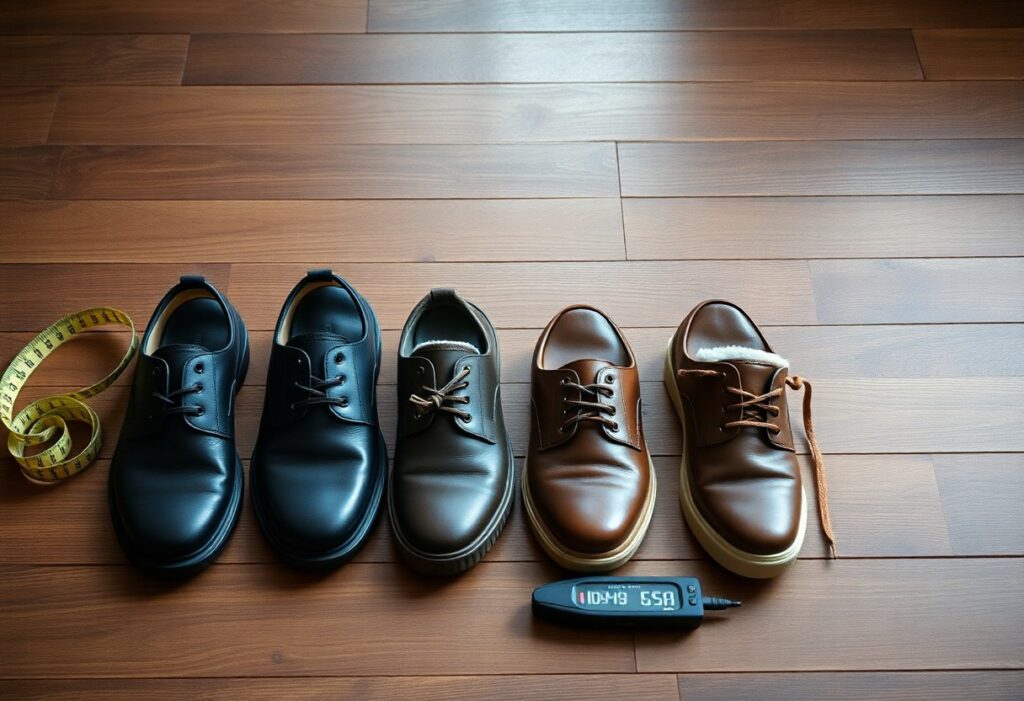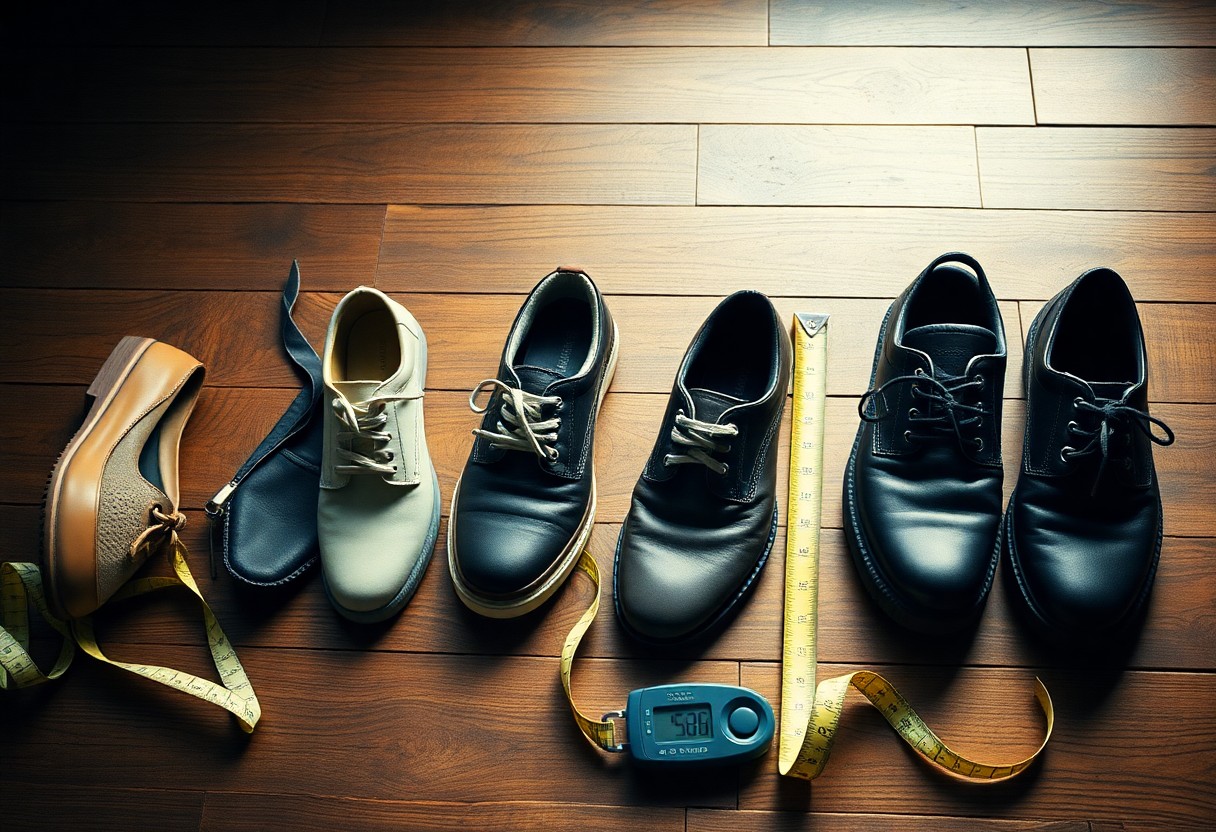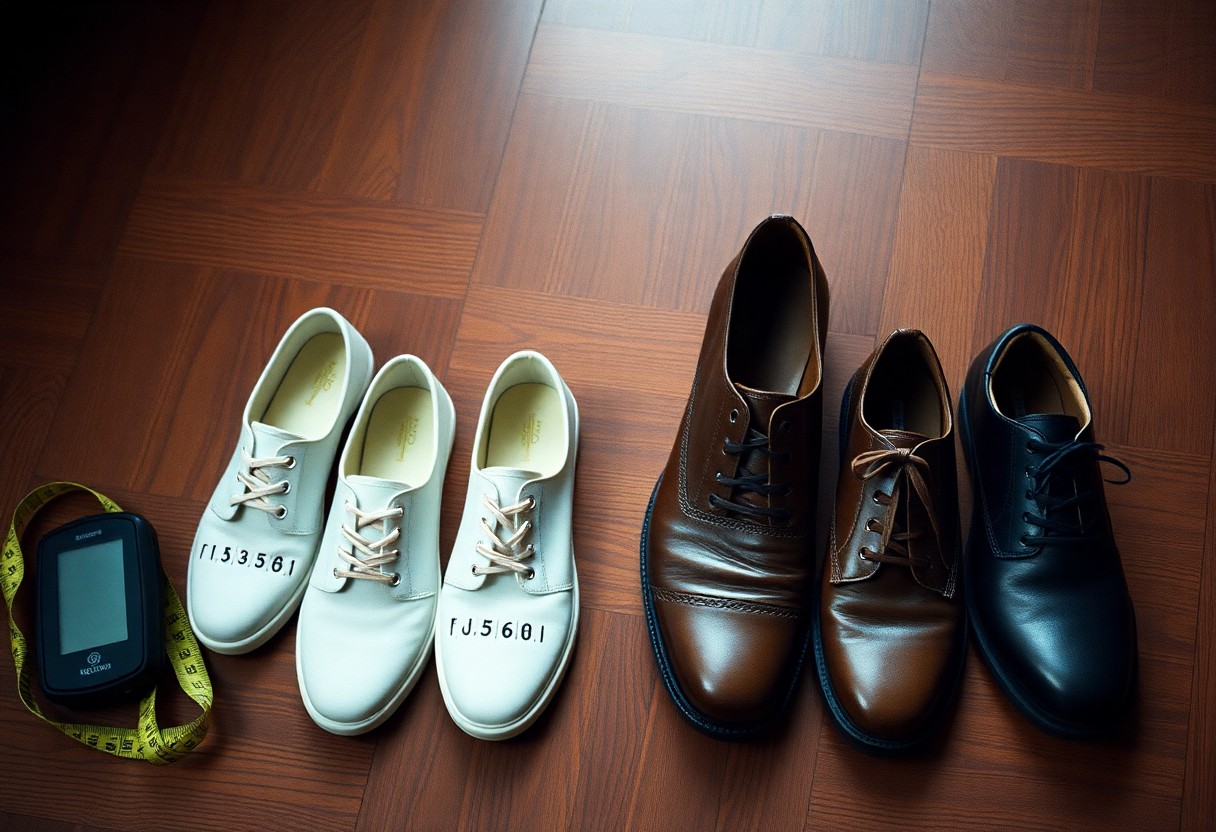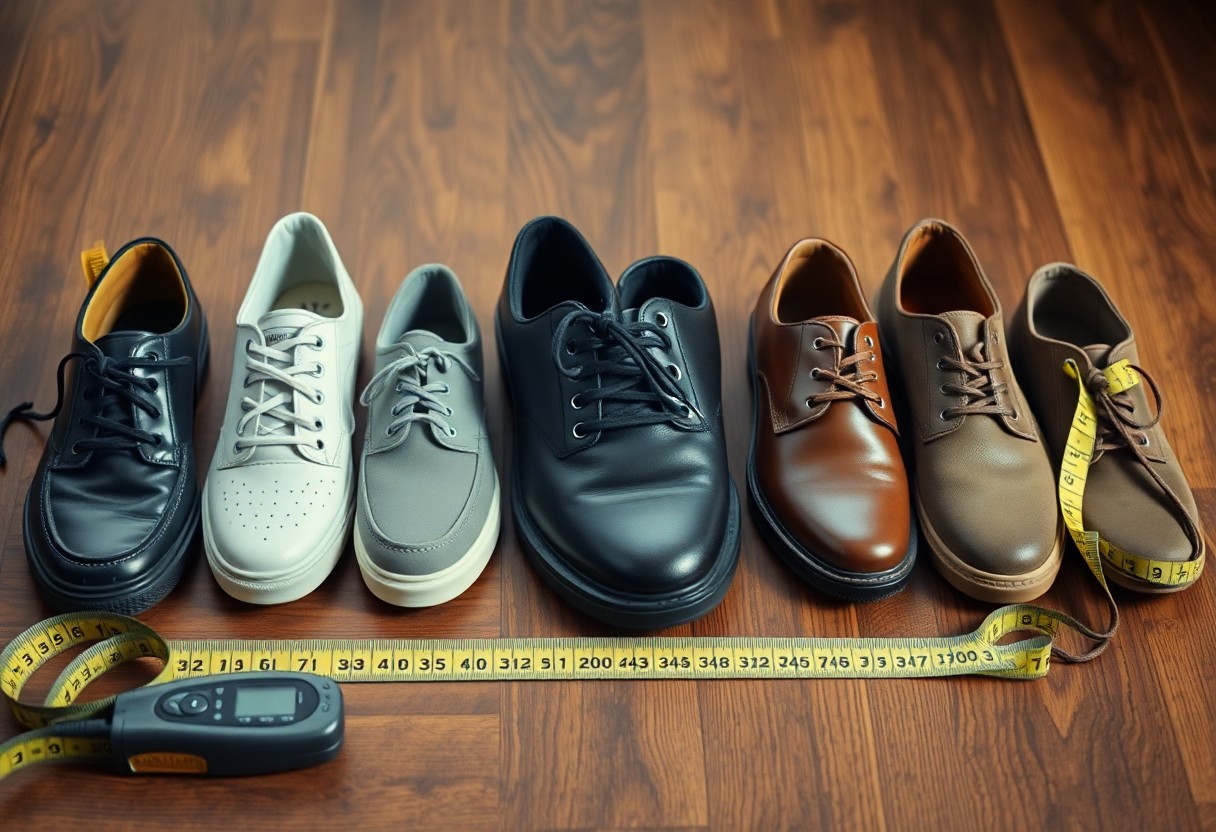
Choosing shoes with the right width is crucial for maintaining optimal foot health and overall comfort. When shoes fit properly, they can significantly reduce foot pain and prevent various health complications. When you shop for footwear, it’s essential to take into account both the length and width, ensuring a comprehensive fit. Selecting shoes with the correct width enhances balance and circulation, while also minimizing the risk of blisters and other foot-related issues. To discover your ideal shoe width, measure the widest part of your foot and refer to standardized width charts. Many shoppers mistakenly prioritize length over width, overlooking the fact that proper width is equally essential for daily comfort and maintaining foot health.
Master the Art of Measuring Your Feet for a Perfect Shoe Fit
The best approach to accurately measure your shoe width is to do so at the end of the day, when your feet are likely to be at their widest due to swelling. Your foot width can vary by as much as half an inch throughout the day, making evening measurements the most reliable for achieving a comfortable fit. To measure effectively, place your foot on a blank sheet of paper and trace its outline while standing. This simple yet effective technique ensures you capture the most precise measurement, guiding you toward shoes that not only fit well but also provide the necessary support and comfort your feet require.
Effective Techniques for Accurate Foot Width Measurement
Besides using a standard ruler, consider employing a Brannock Device, a specialized measuring tool found in most shoe stores, to gauge your foot size accurately. This device allows you to measure the widest part of your foot, which is typically across the ball area. For the best results, take measurements of both feet while standing, as it’s common for one foot to be slightly larger than the other. This practice ensures that you select shoes that accommodate the larger foot, ultimately preventing discomfort during wear and enhancing your overall footwear experience.
Common Pitfalls to Avoid When Choosing Shoe Width
One of the most common mistakes people make when selecting shoe width is underestimating the importance of width measurements. Many individuals focus solely on the length of the shoe, which can lead to discomfort and a range of potential foot ailments. Other frequent errors include measuring feet while seated and mistakenly believing that foot width remains constant throughout life. It’s crucial to understand that wearing shoes that are too narrow can lead to serious foot complications, such as bunions, corns, and hammertoes. Factors like weight gain, pregnancy, or aging can cause foot size changes, so it’s advisable to measure your feet annually. Choosing the right width significantly helps in preventing blisters, calluses, and chronic foot pain.

Comprehending Shoe Width Systems and Standards for Enhanced Fit
Understanding various shoe width systems is vital for ensuring comfort and foot health. Different brands and countries utilize distinct measurement standards, making it crucial to familiarize yourself with these systems to choose footwear that fits appropriately and avoid foot issues. By learning how width is categorized, you can make informed decisions when selecting shoes that cater to your specific requirements.
Understanding Letter-Based Width Scales for Optimal Shoe Fit
While shopping for shoes, you will often find widths labeled from AA to EE. For women, a standard medium width is B, and for men, it is D. Narrow widths range from AA to B, while wide widths extend from D to EE. This letter-based system is designed to help you identify the most suitable fit based on your foot shape, ensuring that your shoes are not only comfortable but also provide the essential support needed for daily activities.
The Influence of International Width Measurement Standards
When shopping globally, you may encounter various measurement systems. For instance, European sizes are based on millimeters, while UK sizes adhere to their unique width standards. Your US shoe size may differ from international measurements by one to two width sizes. Therefore, it’s critical to always consult the brand’s size chart when purchasing shoes from overseas. Japanese shoes tend to run narrower, while European brands often have a wider toe box. To achieve the best fit, measuring your feet in millimeters offers the most accurate reference for international purchases.

How Shoe Construction Impacts Fit and Comfort
Understanding shoe construction is essential for making the best footwear choices for your feet. The way a shoe is built significantly affects both its fit and comfort level. Your comfort is heavily influenced by how the upper part of the shoe connects to the sole and the flexibility of materials around the widest part of your foot. By selecting shoes with thoughtful construction, you can greatly enhance your overall comfort and support, ensuring that your footwear meets your lifestyle needs.
The Advantages of Natural Materials in Footwear
Shoes crafted from genuine leather provide remarkable breathability and adaptability. Leather naturally stretches and conforms to your foot shape over time, resulting in a customized fit. Research shows that leather shoes can expand by up to 30% of their original width, making them an excellent choice for individuals with varying foot widths who are seeking comfort and flexibility in their footwear choices.
Durability and Consistency Offered by Synthetic Shoe Materials
Synthetic materials available today provide consistent width measurements and exceptional durability. These modern materials not only protect your feet but also offer water resistance and enhanced breathability. Many synthetic shoes incorporate mesh panels that improve airflow and flexibility. Moreover, advancements in synthetic materials have led to the integration of comfort features like memory foam and gel inserts. Consequently, shoes can now combine stable width measurements with targeted cushioning, providing excellent support during wear. Recent studies indicate that synthetic materials can maintain their shape up to 40% longer than traditional options, ensuring your shoes retain their proper width throughout their lifespan.

Recognizing Signs of Proper Shoe Width for Maximum Comfort
Proper shoe width is not just about measurements; it’s evident in how your feet feel and function while wearing them. Your shoes should allow your toes to spread naturally during walking, with approximately half an inch of space at the widest part. Research indicates that 70% of individuals wear shoes that are improperly fitted in width, which can lead to various foot problems. Being able to recognize the signs of proper width can significantly aid you in making better footwear choices.
Essential Indicators Signifying Comfort from Correct Shoe Width
Here are some key signs that indicate your shoes fit correctly in terms of width: your toes should be able to wiggle freely, the ball of your foot should comfortably align with the widest part of the shoe, and you should not experience any pinching on the sides. A well-fitting shoe allows your feet to expand naturally throughout the day, as feet can swell by up to 8% by the end of the day due to activity and temperature changes.
Identifying Warning Signs of Incorrect Shoe Width
While wearing shoes, it’s crucial to be alert for warning signs indicating improper width, such as numbness or tingling in your toes, blisters on the sides of your feet, and pressure marks on your skin after removing your shoes. These symptoms may point to shoes being too narrow or too wide. Proper width is vital for preserving foot health, as research suggests that ill-fitting shoes can lead to long-term foot issues. You should feel no pressure points while standing or walking; if you experience pain, redness, or if your foot spills over the edges of the shoe, it’s essential to consider a different width.
Understanding Width Variations Among Different Brands
Numerous shoe manufacturers provide a range of width options, spanning from AA (super narrow) to 4E (extra wide). It’s important to recognize that foot width can fluctuate throughout the day, with studies revealing that up to 70% of individuals have different widths between their left and right feet. Grasping these variations will assist you in selecting shoes that accommodate your unique foot shape, thus preventing discomfort and potential foot complications.
The Influence of Brand Differences on Shoe Width Measurements
When comparing different brands, you may notice substantial discrepancies in width measurements. A medium width in one brand could feel narrow in another. European brands often run narrower than American brands, while athletic footwear companies typically offer the most extensive width options. Trying on shoes before purchasing is always advisable, as sizes can significantly vary across manufacturers.
How Shoe Style Impacts Width Fitting
The style of a shoe plays a significant role in determining how width fits your foot. Athletic shoes generally provide more width flexibility compared to dress shoes, while sandals are designed to accommodate a more natural width. Your foot width requirements may change depending on the shoe’s intended use and the activities you plan to undertake. Further analysis shows that certain styles necessitate specific width considerations. For example, high heels require a secure fit to prevent slipping, while work boots may require additional width to comfortably fit thicker socks. Running shoes should offer around half an inch of space between your longest toe and the shoe’s tip for optimal comfort and performance during use.
Identifying Special Width Requirements for Unique Foot Conditions
While standard sizing options exist, some individuals may require specific width accommodations. If you suffer from conditions like bunions, flat feet, or experience swelling, you might need to opt for wider shoes. Additionally, foot width can change throughout the day, with studies suggesting a potential 4% increase in foot volume by evening. Recognizing these variations is essential for selecting shoes that remain comfortable throughout your daily activities.
Medical Conditions That Necessitate Special Width Accommodations
Special width requirements frequently arise due to medical conditions. For individuals with diabetes, arthritis, or edema, having shoes with extra width allowance for adequate circulation is crucial. Healthcare providers may recommend specific width measurements to mitigate complications associated with these conditions. Studies reveal that 75% of individuals with foot conditions benefit from specialized width fittings, underscoring the importance of selecting the right footwear.
Activity-Specific Width Needs for Enhanced Performance
An active lifestyle demands different shoe widths for various activities. For instance, your running shoes may require more width than your casual footwear, while hiking boots need enough space to accommodate thick socks. Athletes generally benefit from shoes that are half a size to a full size wider for high-impact activities, allowing for necessary foot expansion during performance. When fitting for specific activities, consider your foot’s natural movement patterns. During running, your feet can spread up to half a size wider. For sports that involve lateral movements, such as tennis or basketball, ensuring adequate width is vital to prevent foot strain and potential injuries. Your choices should align with your activity level and individual foot characteristics.
Discovering Your Ideal Shoe Width for Lasting Comfort
The journey to finding your perfect shoe width begins with understanding proper measurement techniques and available width options. By measuring your feet at their widest point, identifying your width category (ranging from A to E), and selecting shoes that correspond to your measurements, you can guarantee lasting comfort. Your shoes should fit snugly without causing pinching or sliding, allowing your toes the freedom to move naturally. By selecting the right width and choosing materials that suit your feet, you can enjoy comfortable, well-fitting footwear that effectively supports your daily activities.
Answers to Common Questions About Shoe Width
Q: What is the best way to measure my foot width at home?
A: To measure your foot width accurately, place your foot on a blank sheet of paper and trace its outline. Focus on measuring the widest part, typically at the ball of your foot, using a ruler. Taking measurements in the afternoon when your feet are at their largest is recommended. Don’t forget to measure both feet, as one may be wider than the other. Use these measurements to compare with the shoe width charts provided by manufacturers.
Q: What are the standard width measurements for shoes?
A: Shoe widths generally utilize letter codes from A to E. For women, the standard medium width is B, while for men, it’s D. Narrow widths are indicated by A and AA, while C and D represent medium-wide for women. E and EE signify wide widths. Keep in mind that each brand may have slight variations in their width measurements, so it’s prudent to check their specific size charts before making a purchase.
Q: How can I tell if my current shoes are the wrong width?
A: Look for indicators such as red marks on the sides of your feet, numbness in your toes, blisters on your heels or sides, and shoes that slip off while walking. Your toes should have sufficient space to wiggle freely, and the ball of your foot should fit comfortably at the widest part of the shoe. If you feel pressure on the sides, it may be time to consider a wider shoe. Conversely, if your foot shifts side-to-side, you may need a narrower width.
The Article How to choose the right shoe width tips for a comfortable fit appeared first on My Shoes Finder
The Article Choosing the Right Shoe Width for Ultimate Comfort Was Found On https://limitsofstrategy.com


4 Responses
I found your insights on shoe width particularly resonant, as I’ve experienced firsthand how crucial it is for comfort and overall foot health. Not too long ago, I decided to invest in a pair of athletic shoes without considering width, thinking that as long as they were the right size, I would be fine. However, after a few runs, I ended up with blisters and discomfort that made me rethink my shoe choices entirely.
It’s interesting how much of a difference shoe width can make, isn’t it? It seems like a small detail, but when you’re out there running, it’s everything. I know the feeling you’re describing—getting excited about a new pair of shoes only to find out they’re not what you expected. Blisters can be a real party crasher on your fitness journey.
You’re so right about shoe width being a game changer. It’s one of those details that often gets overlooked, especially when we’re dazzled by the latest designs or tech features. I remember getting a pair that looked fantastic but left my feet feeling miserable within a couple of miles. Blisters become almost inevitable if you’re not careful.
I really appreciate how you highlight the importance of shoe width alongside length. I used to focus solely on length until I started experiencing discomfort during my daily walks. After realizing my feet were wider than I thought, I measured them properly (definitely at the end of the day as you suggested) and found a pair that fit perfectly. It made such a difference!